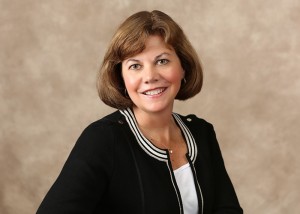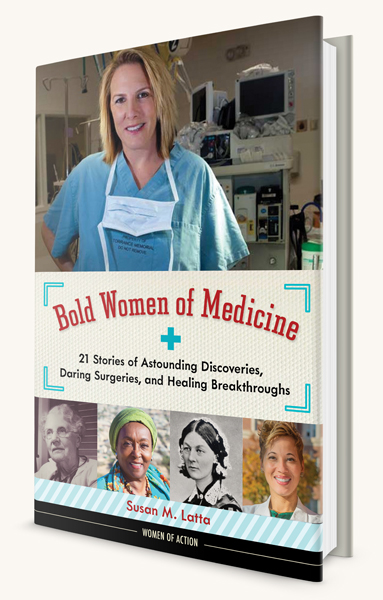 Serving as inspiration for any young woman who wants to make a difference in the world, these women revolutionized the medical field by breaking barriers and battling discrimination. From the 19th century battlefields of Crimea to the modern, barren landscape of Antarctica, these 21 pioneers used determination and their knowledge of science to overcome the hurdles they faced. Published this September to coincide with Women in Medicine Month, Bold Women of Medicine is an enlightening, essential addition to any aspiring doctor or nurse’s bookshelf.
Serving as inspiration for any young woman who wants to make a difference in the world, these women revolutionized the medical field by breaking barriers and battling discrimination. From the 19th century battlefields of Crimea to the modern, barren landscape of Antarctica, these 21 pioneers used determination and their knowledge of science to overcome the hurdles they faced. Published this September to coincide with Women in Medicine Month, Bold Women of Medicine is an enlightening, essential addition to any aspiring doctor or nurse’s bookshelf.
Author Susan M. Latta took the time to talk to us about her motivations behind the book, honoring the past and changing the future.
What first drew you to this topic? Why did you decide to write about women in medicine?
My daughter was in the process of applying to medical school and I witnessed the effort she was putting into her career choice. At the same time, I discovered CRP’s Women of Action series, and thought about the trials the pioneering women in medicine must have gone through. With the momentum for women to go into STEM careers, I thought this would be a perfect way to see how women have evolved in their push for equality in science. Women still have a long way to go, but each new woman that enters the field advances the cause.
This book includes women from all areas of medicine, from nursing to surgery to physical therapy. Why was it important to you to cover such a broad spectrum of medical care?
It was important to cover as many different healthcare careers as possible to show young women that working in healthcare does not just mean becoming a physician. There are many careers for women in healthcare from physical and occupational therapy to nursing, midwifery, dental hygienists, dentists, physicians, surgeons and many more. The number of women working in healthcare increases every year.
How did you capture both the psychological and physical experiences of these women, especially in cases like Kathy Magliato’s surgeries and Jerri Neilsen’s biopsy?
I tried to get at the heart (no pun intended) of Kathy Magliato’s struggles and victories. My education was not in science, so the idea alone of operating on someone gives me the shakes. How does it feel to use a scalpel and have someone’s life in your hands? I imagine it must be thrilling and terrifying at the same time. To get the feel of Kathy Magliato’s day in the operating room, I asked her to describe it to me. Wall coloring, flooring, types of assistants, the tension level, the kind of music she listens to, etc. Each detail helped me to relay her experiences to readers.
And in the case of Jerri Nielsen’s experience I was able to read about her life through her wonderful memoir Icebound: A Doctor’s Incredible Battle for Survival at the South Pole. I tried to select quotes and stories that illustrated how frightening it must have been to be stranded in such a hostile environment and have to perform an essential procedure on yourself. Her courage was both incredible and inspiring.
All of these women experienced sexism or gender specific challenges as they fought to make their way in male-dominated fields. How has the fight for women in medicine progressed over the years, and where do you still see the most room for improvement?
Many healthcare specialties such as cardiology (where women make up 12 percent of the practicing physicians) and orthopedic surgery (9 percent) are still male dominated, but women are making headway. Most challenges today exist in women earning equal wages. The 2016 Medscape Physician Compensation Report states that overall, women physicians make 24 percent less than their male peers. With the same skills and training as men, women should not have to fight for equal pay. And in the academic world, women are still less likely to become full professors. One bright note was that women’s earnings increased more than men’s earning did between the 2012 and 2016 Medscape reports.
Trailblazers like Rebecca Lee Crumpler, Rebecca Cole and Susan La Flesche Picotte had to face additional challenges as women of color. How did their perseverance affect the advancement of women in medicine?
Rebecca Lee Crumpler, Rebecca Cole and Susan La Flesche Picotte focused on the comfort and practical healthcare instruction they could give to others by becoming physicians. The early women physicians learned a degree wasn’t worth anything without hands-on training, and most training facilities didn’t allow any women, much less women of color. African American physicians Susan Smith McKinney Steward, Sarah G. Jones and Lucy Hughes Brown founded post-graduate training schools to advance education for those that followed. Susan La Flesche Picotte focused on helping her people on the Omaha Reservation and her sacrifice taught other Native Americans the way to sustained good health. Women also learned to highlight their distinctness from men by displaying their emotions in practicing medicine. As Betha Van Hoosen said, “The study of medicine develops tenderness, sympathy, tolerance and benevolence.”
Some of the doctors tackle very hard-hitting global issues, such as female genital mutilation in Somaliland and fistulas in Ethiopia. How did you discuss these topics in an age-appropriate way for YA readers?
These two chapters were tough to write. The horrors these women have experienced and many still experience are unbelievable. Writing about medicine automatically lends itself to topics we don’t want to hear about. With these issues, I tried to use accessible language that YA readers would understand and at the same time expose them to the suffering of women around the world. I also wanted to demonstrate how the unforgettable, caring and tireless work of Catherine Hamlin and Edna Adan can change lives.
How can we empower young women and girls to pursue STEM careers, especially in the medical field?
I think that women pursuing STEM careers can benefit greatly from mentors in those fields. Bonnie Simpson Mason and Sherrie Ballantine-Talmadge are two of the mentors that I wanted to expose to girls interested in STEM careers. Both of these women have an interest in training future healthcare workers by way of mentorship. As Bonnie Simpson Mason said to me, “None of us has done it alone.” And in the field of sports medicine, Sherrie Ballantine-Talmadge teaches young women how to cope with body issues, concussions and exhausting training for sports they love.
Showing girls careers where they can see themselves making a difference will encourage them to pursue those careers. Young women can learn by seeing what has been done before them and, in turn, once they have been successful they too can mentor younger girls. You have to know what’s out there, and once young women are educated in the myriad of opportunities they can choose what is best for them.
September was Women in Medicine month. What can we do to thank medical mavens of past and present?
I think the best way to honor past and present medical mavens is to emulate them. Learn about their lives and their accomplishments even if you’re not directly involved in a health field career. History can be a wonderful teacher.
What do you hope readers take away from Bold Women of Medicine?
I hope readers will take away the power of hope, education and perseverance. If you have the will to accomplish something (in any career), you’re over halfway there. The Bold Women of Medicine survived many failures on their way to success, but they believed in both themselves and their goals. They didn’t let anyone deter them even when they were up against insurmountable odds. They didn’t listen to those that didn’t approve of their choices, they just powered on through. When they needed more explanation, they sought the answers through education. Edna Adan said, “Education is one of the strongest gifts we can give a human being and particularly a woman in Africa.” The Bold Women of Medicine, whether historical or present day, have the power to assess emergencies and everyday situations and jump into action. Their love for both compassion and science fuels them.

“The paths to the profession are myriad, and readers with an interest in helping and healing will find plenty of inspiration.” —Booklist
“This volume provides an impressive overview of women in medicine and includes suggestions for further reading for those interested in more information.” —VOYA
“A read packed with brief yet thought-provoking stories of fearless women in medicine.” —School Library Journal
Bold Women of Medicine: 21 Stories of Astounding Discoveries, Daring Surgeries, and Healing Breakthroughs is available wherever books and e-books are sold.
1 Comment
Although I am far from being a teenaged girl, I truly enjoyed your book: Bold Women of Medicine. It was an example of quality writing that flowed easily. However, I think I found a typo, p. 86, paragraph 2, sentence 3. “Each afternoon she POURED over,,,” That would have been messy, and ruined the book. I think it escaped editing, and should have been PORED, meaning reading carefully. Maybe a victim of spell check? In future editions, please have this corrected.
Should be required reading for boys and girls in junior high!